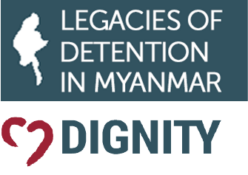The 15th March 2019 was quite a day for the Legacies of Detention project. Simultaneously across two hemispheres key events were taking place that demonstrate some of the achievements of the project so far. In Copenhagen PhD fellow Liv Gaborit together with former political prisoner Leytar Tun launched an exhibition of photographs taken by a group of former prisoners (Letyar Tun, Sai Minn Thein, Pho Nyi Htwe and Phyoe Dhana Chit Lynn Htike) in Yangon reflecting the contemporary struggles they and their families face. The photos, which have also been displayed in Myanmar, are the product of an action research component of Liv’s doctoral research that focuses on experiences of imprisonment with a focus on recognition. From Liv’s perspective and that of the Legacies team in Denmark, the exhibition itself serves as a gesture of recognition of the hardships and sufferings of the many people who participated (and still do) in the struggle towards democracy and justice in Myanmar. It is also a sign of what is possible today by way of co-production of knowledge given the right combination of tenacity, courage and willingness to become ethnographically embedded that is necessary to build the right kind of relationships to follow through on such an endeavour.
On the same day over 16000 km away our local project partners, Justice for All Law Firm, presented at one of the most prestigious academic conferences on Myanmar, the Myanmar Update conference held at the Australian National University’s Myanmar Research Centre. On behalf of the research team (U Than Htaik, Kyaw Lin Naing, Nwe Ni Aung and Aung Lin Oo), Kyaw Lin Naing presented the results of a qualitative case study conducted on the topic of Prisoners’ Contact With the Outside World. The presentation featured a description of the case study methodology, the significance of the topic and a synthesis of the findings. In brief the case study confirms the way in which contact with the outside world is important to prisoners to sustain them physically and emotionally and documents the variety of forms such contact takes across different types of detention facility. The study also illuminates the great lengths family members go to, to ensure contact and the hindrances they have often faced. The conference was a fantastic opportunity to disseminate this recently generated knowledge. This was the team’s first experience of participating in such a conference and the first opportunity to expose an audience of scholars from and beyond Myanmar to the research methods applied and the findings. In addition, Principal Investigator Andrew M. Jefferson presented at the conference based on data collected from a series of interviews with ex-prisoners now occupying positions of political authority. Jefferson argued that the various disruptions that feature in the lives of the former political prisoners should be understood as links in life trajectories rather than breaks, an argument that might reasonably be extended to the way we think of the ongoing sociopolitical transition in Myanmar.
So, from the project’s point of view there is cause for celebration and we hope the reader might identify with our sense of achievement. And yet at the same time as we cautiously register some achievements we are conscious of the bigger socio-political picture that frames the two events we report on here: Myanmar is still in flux; freedom of speech is still limited; gross human rights violations continue; the peace process has stalled; political authority is highly centralized; substantial political power remains in the hands of the military; dreams of a unified federal state are not shared by all and seem out of reach; and while the positively-oriented recalibration of the relationship between state and citizen one might associate with a shift towards a consolidating democracy can be sensed in certain quarters there remains a long way to go before the anticipated fruits of the changing political dispensation are available and accessible to all.
The photo exhibition will be exhibited at Kulturhuset Indre By at least until June 1. Click here to read more about the exhibition in an article written by Globalnyt (in Danish).
